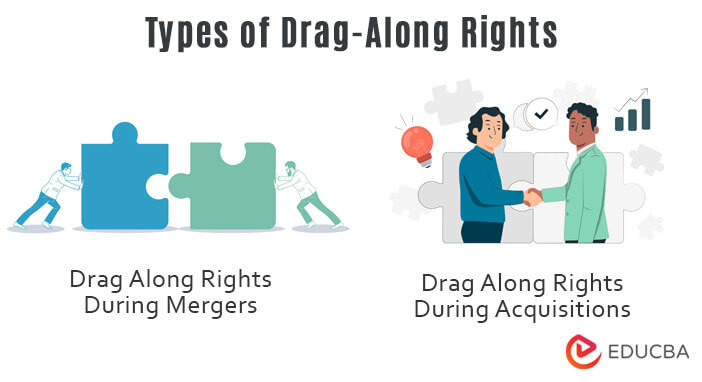Updated July 25, 2023
Definition of Drag-Along Rights
Drag-along rights are defined as the facility where the shareholder having a majority stake can influence the shareholder having a minority stake to come along in the business or company’s sale.
The majority of shareholders offer the same price, covenants, and terms to stakeholders having a minority stake in the company. These rights help in the safeguarding of major stakeholders.
Types of Drag-Along Rights
The various types are given below:
1. Drag Along Rights During Mergers
In the merger deal, there could be an incorporation of new drag-along rights. During the merger, the majority of stakeholders of the merging unit may exercise these rights, which drags minority stakeholders to complete the deal of the merger with the bigger unit. As a result, the majority and minority stakeholders share similar and homogenous terms and conditions along with the price for the deal undertaken.
2. Drag Along Rights During Acquisitions
In a lot of acquisitions, the majority owners exercise drag-along rights to drag minority shareholders to participate in the acquisition of a new unit. Thus, under such deals of acquisitions, the minority stakeholders get similar ownership and rights as the majority stakeholders when acquiring a new business unit.
Components
Given below are the top 5 important components:
1. Shareholder Agreement
The shareholder agreement is defined as the agreement that jots down the ground rules for a business’s shareholding pattern. It describes the rights and liabilities of each shareholder in the business. It also details the provision and tag-along rights.
2. Majority of Stakeholders
These are defined as the stakeholders that hold majority ownership of the business. Their ownership normally exceeds fifty percent towards the share ownership of the business.
3. Minority of Stakeholders
The minority stakeholders are the ones who carry residual claims or ownership of the shares of the business. There may be one or more minority stakeholders, and the total ownership normally falls below the fifty percent ownership of shares.
4. Offer Price
The offer price is defined as the buyer’s price to the seller wherein the seller further agrees to sell off assets or the company to the buyer. Thus, the offer price tends to be homogeneous.
5. Deal Type
The type of deal for which drag-along rights are exercised becomes important. For example, a deal could be a merger or an acquisition. If the majority ownership gets the potential buyer who is willing to purchase 100% ownership at a price acceptable to the majority owners, then the majority owners can enforce.
Example
Suppose there are preference shareholders in the company. They additionally represent 30 percent of the common shares, which could be fully diluted at a later stage of the business. The preferred stockholders are in touch with potential buyers.
They can potentially employ drag-along rights in relation to common shareholders and founders if the potential buyer offers a good deal. The preferred stockholders convey the offer terms and prices to the common stakeholders by exercising the drag-along rights to initiate the sale of the asset or the company.
Practical Example:
For the period 2019, there was a merger deal with the Bristol-Myers and Celgene Corporation. Under this deal, the former company would acquire a stake in the latter company. The deal of $74 billion was accomplished through stock transactions and cash transactions.
Under the term of the deals, the drag-along rights were to be exercised, so the minority shareholders were dragged along with the majority stakeholders to gain the majority ownership of the combined unit.
Advantages and Disadvantages
Given below are the advantages and disadvantages mentioned:
Advantages
- The drag-along rights are formulated to safeguard the rights of majority shareholders.
- It also becomes useful for minority stakeholders.
- These rights help in making the terms and offer price of the deal favorable and homogenous.
- The rights are brought into action during the negotiations of investment that took place between the minority stakeholder and majority stakeholders.
- The drag-along rights, when exercised, replace the governing rights and non-controlling interests of the stakeholders having a minority stake.
Disadvantages
- The minority stakeholders may always end up with illiquid assets on the completion of the deal.
- The minority stakeholders may become unsupportive or refuse to comply with the deal pursued by the majority of stakeholders.
- The majority of stockholders must ensure statutory requirements when they act on behalf of the shareholders who have minority ownership.
Limitations
- Once the business goes for an initial public offering, the drag-along rights tend to cease.
- The minority stakeholders can execute a phase of back-out wherein drag-along rights are delayed.
- Most stakeholders will have to look for proxy rights irrevocable in nature if the minority stakeholders fail to support the deal.
Important Points to Noted
- Whenever a company formulates articles of association, the terms and tag-along rights are mentioned in them.
- The drag-along rights and tag-along rights are made as part of the agreements of shareholders.
- These are not classified as statutory rights.
- It comes to the limelight when there are investment negotiations in place between minority and majority shareholders.
- The majority of stakeholders have to provide advance notice on the exercise of drag-along rights to the minority stakeholders, which is to be done within shareholder agreements’ governing guidelines.
Conclusion – Drag Along Rights
It helps in selling off the 100 percent ownership in the business to prospective buyers by eliminating the minority shareholders. Drag-along should not be confused with tag-along rights as tag-along rights safeguard the minority stakeholders, whereas drag-along rights safeguard the majority stakeholders. However, when the business decides to go for the initial public offering and wants to become public, the drag-along and tag-along rights are eliminated there and then. The provisions are well documented in the shareholder agreements. To enforce a drag-along right, the majority shareholder must provide advance notice to the minority stakeholders.
Recommended Articles
This is a guide to Drag-Along Rights. Here we discuss the types and components along with advantages and disadvantages. You may also look at the following articles to learn more –



